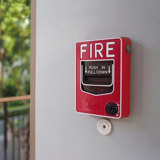Control energy usage right down to the second. Schedules help to actively manage energy use and reduce costs by ensuring lighting, hot water and air conditioning switches on and off based on opening hours. When a schedule becomes valid or invalid, the event logged in Protege is sent to the BMS which is then able to carry out a predefined action.
Building Management Systems

Buildings made smarter
Protege integrates with many Building Management Systems (BMS) to control large HVAC, lighting, energy, fire and elevator solutions. Integrating the two systems can greatly reduce energy consumption and operating costs, as well as providing control from one centrally managed system.
Access control systems hold a wealth of data about a building and the occupants – who is onsite, where they are, and even where they are likely to be going. Knowing when an area is occupied and how many people are in a room, allows for tight integration with building management systems. The armed status of a building is a simple way of determining that a building is unoccupied, and can be used to turn off lighting and non-essential items such as photocopiers, coffee machines, and monitors. When the building is disarmed, we know who is in the building and what areas they have access to, so only need to turn on lighting for the areas they require, and progressively turn on others as more people arrive.
As users arrive for the day, their entry events are sent to the BMS which automatically sets the appropriate lighting levels for the rooms in use, brings the HVAC up to a comfortable temperature and powers the necessary appliances.
A fire alarm or smoke detector managed by the BMS is able to trigger Protege to provide egress for users evacuating the building. This enables users to take the best route out of a building during an emergency without having to worry about which doors their card allows them to unlock.
In the event of an alarm being activated, lighting is able to come on automatically providing the added benefit of better security camera footage outside hours when lights would otherwise be off.





Using Modbus
When using Modbus, the Protege controller acts as the Modbus slave and communicates with the BMS server (Modbus master) via the Ethernet. The BMS server is notified when someone locks or unlocks a door, an area is armed or disarmed, a schedules goes valid or invalid, or when motion is detected. Once this information has been passed to the BMS, it is able to make intelligent decisions about what to turn on or off. Integration also enables the BMS to communicate the status of the building, allowing Protege to effectively control access during an emergency or in the event of a fire.


Automation and Control
Designed to allow third party products to communicate directly with Protege controllers, the Automation and Control protocol defines how the systems communicate and enables you to control your security system, building access, air-conditioning and lighting from a single interface without the need for overly complicated software.


